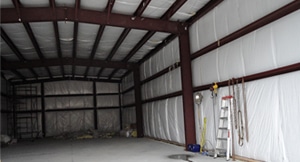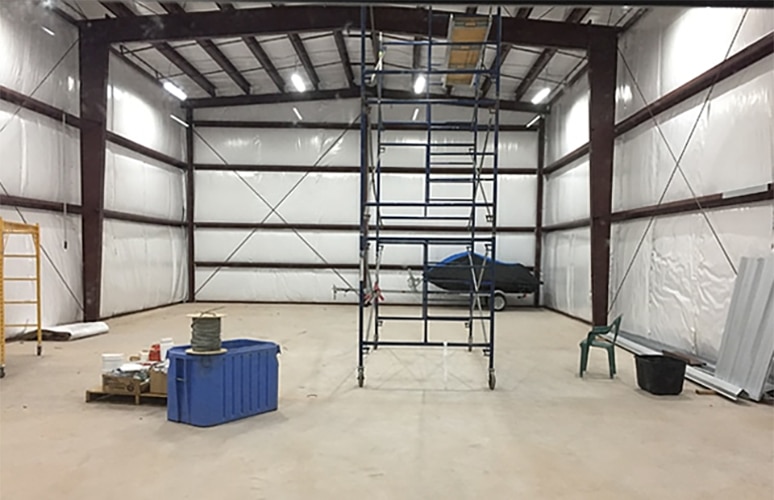How to Insulate a Steel Building

Mold, Mildew, Rust, and Corrosion
In addition to keeping the building comfortable, you should also insulate a steel building to prevent moisture from entering the structure through condensation. Condensation becomes a problem when the indoor and outside temperatures are at a significant variance. As moisture accumulates, mold and mildew will begin to grow, which can be a serious health concern for people with allergies or respiratory problems. Additionally, failure to sustain proper building maintenance practices can and will result in the moisture causing corrosion and rust.
How to Insulate a Steel Building
Traditional construction materials will typically require the insulation to be installed between the studs. When it comes to the procedures to insulate a steel building, insulation is usually installed above the framing, which provides more continuous protection. Its placement prevents the transfer of heat as well as moisture in between the framing, exterior roof, and wall panels.
Types of Steel Building Insulation
There are four different types of materials used to insulate a steel building, and each material has varying costs as well as benefits. When you are considering which material is best to insulate a steel building, keep in mind the characteristics of the material should match with the building’s shape, size, geographic location, and the building’s intended use.
1) Reflective Foil
Reflective foil or foil bubble is a waterproof type of insulation with a reflective surface, which can significantly brighten the exterior of the building. In some cases, reflective foil is more costly, but it’s relatively simple to install. All you need are staples, glue, or nails, and reflective foil doesn’t require any special protective gear or equipment.
2) Fiberglass
As the most popular and least expensive method used to insulate a steel building, fiberglass comes in a “blanket” or rolls of material and doesn’t require professional installation. However, it’s a great idea to wear protective clothing, especially a mask because fiberglass will shred into fine fibers and irritate your skin. Due to the soft batting fiberglass material and its ability to absorb moisture, it will also attract rodents, birds, and nesting bugs. As a solution, fiberglass is generally sold with a protective facing, which doubles for interior appeal.
3) Insulated Panels
Insulated panels are made of two metal panels with insulating foam core between them. As one of the more expensive ways to insulate a steel building, insulated panels reduces the need for rigid board installation or fiberglass blankets. In any case, when you use insulated panels to insulate a steel building, the panels will provide great insulation, fast installation, and a modernized appearance.
4) Rigid Board
As the universal way to insulate a steel building, foam or “rigid boards” are ideal for practically any type of climate. With several available performance ratings, rigid boards are an effective way to insulate a steel building as well as dampen the exterior noise. In addition, using rigid boards to insulate a steel building doesn’t require a professional and is simple to install. However, you should inform the provider or seller of your steel building of your intent to use rigid boards as the method to insulate a steel building. When you use rigid boards for insulation, you will need longer panel lengths and extended fasteners.
Why Do I Need Steel Building Insulation?
The uses and requirements of buildings differ. As such, not every metal building requires insulation. However, if you want to save money on heating and cooling, or live in an area with significant temperature fluctuations, metal building insulation might be an idea worth exploring. For most first-time buyers, metal building insulation might not have crossed your mind. However, if you want your building to serve you well for many decades, insulation is vital. Not only does metal building insulation help regulate interior temperatures as seasons change, but it also prevents condensation by creating a barrier throughout the walls and roof of your building.
What Are U-Values, R-Values And Vapor Retarders?
The U-Value
This term describes the specific thermal performance of a building’s envelope assembly, such as the sidewall systems or the roof. A complete assembly consisting of several heat flow paths has a specific U-value dependent on the materials in the series heat flow.
The R-Value
This value indicates the level of a building’s thermal resistance or how well the insulation works. When considering metal building insulation, look for a high R-value, which indicates high thermal resistance. A higher R-value insulation is better than a low R-value insulator.
A Vapour Retarder
As the name suggests, this is a facing that slows or prevents the flow of moisture through the attached insulation. A superior vapour retarder has low permeance. Additionally, vapour retarders are often required to be fire retardant.
Factors to Consider for Metal Building Insulation
The following are a few important factors to consider when insulating a metal building:
- Climate: The climate will greatly impact the type and amount of insulation needed. For example, buildings in colder climates will require more insulation to maintain a comfortable temperature inside.
- Building Use: The purpose of the metal building will play a role in determining the insulation needs. For instance, a warehouse may require less insulation than an office or living space.
- Building Features: The size, shape, and construction of the metal building will also affect insulation needs. Buildings with high ceilings or large open spaces may require different types of insulation compared to smaller structures.
- Energy Efficiency: Properly insulating a building can help reduce heating and cooling costs, making it more sustainable and cost-effective in the long run.
- Moisture Control: Metal buildings can be susceptible to moisture buildup due to temperature fluctuations, leading to mold growth and structural damage. Proper insulation can help control moisture and prevent these problems from occurring.
- Fire Safety: Depending on the building’s use, fire safety may be a concern when selecting insulation. There are various types of fire-resistant insulation available that can increase the safety of a metal building.
- Budget: Consider your budget when selecting insulation for a metal building, as well as the long-term cost savings that proper insulation can provide.
- Maintenance: Consider the level of upkeep needed for different types of insulation when making your decision.
Frequently Asked Questions
Q1. What Is the Best Insulation for A Metal Building?
The most popular choice of steel building insulation is fibreglass batts. Batts, also known as ‘blanket insulation,’ is effective and economical. A vapour barrier is also a great solution acting as a moisture retardant to help protect the insulation. At Toro, we offer a convenient, custom measured pin and cap insulation system for our arch buildings.
Q2. Where Should I Insulate My Metal Buildings?
It depends on your location, type, and use of the building. However, you should install some type of insulation in the roof of your structure. Additionally, we recommend that you also insulate the walls if your area experiences varying weather patterns. For example, if snow piles up against your building’s sidewalls, you should strongly consider insulating the walls. This will prevent condensation. In most cases, a steel building is installed by sandwiching the insulation.
Q3. What Are the Different Types Of Condensation That Can Occur In Metal Buildings?
Visible condensation occurs on surfaces as water, ice or frost. You may see it on vapour retarders, insulation, cold water pipes, skylights, and cooling ducts.
Concealed condensation is more damaging than visible condensation and harder to deal with. It occurs when moisture passes into the interior of the building and condenses on a surface that has a temperature at or below the dew point.
Q4. How Do You Stop Condensation in A Metal Building?
Insulate your metal buildings. Prevent contact between the humid, warm air and the dry, cold metal panels by installing good vinyl-backed insulation on the walls and the roof of your metal building.
Ensure good air circulation. Use fans to increase evaporation if necessary.
Make sure you have proper ventilation. Vent oil or gas heaters directly to the outside. You can also add ceiling vents that allow moist warm air to escape to the outside, particularly if your building has a lot of equipment or many people working.
Review lighting fixtures. Lighting affects the indoor moisture levels in your metal building in different ways. Ensure that they are not encouraging heat build-up.
Get the Best Roof and Wall Insulation Solutions
We offer a variety of insulation options for both their straight-wall and steel arch buildings. For information about our metal building insulation solutions or metal building kits, contact us or call 1-877-870-8676 today.
Also Read: What Insulation Type Is Most Suitable for Metal Buildings?
Related Post






